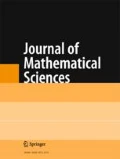We consider a mathematical model of elastic body with thin inclusion or coating in the form of a thin elastic shell. It is shown that the corresponding Steklov–Poincaré operator of the mathematical model possesses the properties guaranteeing the existence and uniqueness of a weak solution of the boundary-value problem. We propose a method of solution based on the domain decomposition algorithm with the use of the boundary-element and finite-element methods. We prove the convergence of the iterative domain decomposition method and present the results of numerical experiments.
Similar content being viewed by others
References
V. M. Aleksandrov and S. M. Mkhitaryan, Contact Problems for Bodies with Thin Coatings and Interlayers [in Russian], Nauka, Moscow (1983).
L. I. Vynnyts’ka, Mathematical Modeling in the Mechanics of Deformation of Elastic Bodies with Thin Soft Inclusions [in Ukrainian], Candidate-Degree Thesis (Physics and Mathematics), Lviv (2009).
L. Vynnyts’ka and Ya. Savula, “Stress-strain state of the body with thin inclusion,” Fiz.-Mat. Model. Inform. Tekhnol., Issue 7, 21–29 (2008).
B. L. Pelekh, Generalized Theory of Shells [in Russian], Vyshcha Shkola, Lvov (1978).
Ya. G. Savula, I. I. Dyyak, and A. V. Dubovik, “Use of a combination model to calculate the stress-strain state of three-dimensional structures,” Prikl. Mekh., 25, No. 9, 62–67 (1989); English translation: Int. Appl. Mech., 25, No. 9, 904–909 (1989).
H. T. Sulym, Fundamentals of the Mathematical Theory of Thermoelastic Equilibrium of Deformable Solid Bodies with Thin Inclusions [in Ukrainian], Shevchenko Scientific Society, Lviv (2007).
I. I. Dyyak and Ya. H. Savula, “D-adaptive mathematical model of solid body with thin coating,” Mat. Stud., 7, No. 1, 103–109 (1997).
I. Dyyak, Ya. Savula, and A. Styahar, “Numerical investigation of the plain strain state for a body with thin cover using domain decomposition,” Zh. Obchysl. Prykl. Mat., No. 3 (109), 23–33 (2012).
G. C. Hsiao and W. L. Wendland, Boundary Integral Equations, Springer, Berlin (2008).
I. Makar, Ya. Savula and A. Styahar, “Numerical analysis of a multiscale model of the elastic body with the thin cover,” Fiz.-Mat. Model. Inform. Tekhnol., Issue 15, 49–55 (2012).
Ia. Pasternak and H. Sulym, “Stress state of solids containing thin elastic crooked inclusions,” J. Eng. Math., 78, No. 1, 167–180 (2013).
A. Quarteroni and A. Valli, Domain Decomposition Methods for Partial Differential Equations, Oxford Univ. Press, Oxford (1999).
K. Riederer, C. Duenser, and G. Beer, “Simulation of the linear inclusions with the BEM,” Eng. Anal. Bound. Elem., 33, No. 7, 959–965 (2009).
Ya. H. Savula, I. I. Dyyak, and V. V. Krevs, “Heterogeneous mathematical models in numerical analysis of structures,” Comput. Math. Appl., 42, Nos. 8–9, 1201–1216 (2001).
Ya. Savula, H. Mang, I. Dyyak, and N. Pauk, “Coupled boundary and finite element analysis of a special class of two-dimensional problems of the theory of elasticity,” Comput. Struct., 75, No. 2, 157–165 (2000).
Ya. Savula and A. Styahar, “Numerical simulation of the bodies with thin covers and inclusions using FEM/BEM coupling with domain decomposition algorithm,” in: Abstracts of the 8 th Internat. Conf. “Porous Materials: Theory and Experiment” INTERPOR’ 12 (September 18–22, 2012, Lviv–Briukhovychi, Ukraine), Lviv (2012), pp. 105–106.
B. Štok and N. Mole, “Coupling FEM and BEM for computationally efficient solutions of multi-physics and multi-domain problems,” Eng. Comput., 22, Nos. 5–6, 711–738 (2005).
Author information
Authors and Affiliations
Additional information
Translated from Matematychni Metody ta Fizyko-Mekhanichni Polya, Vol. 57, No. 3, pp. 119–131, July–September, 2014.
Rights and permissions
About this article
Cite this article
Styahar, A.O., Savula, Y.H. & Dyyak, I.I. Numerical Analysis of the Stress-Strain State of a Body with Thin Inclusion by the Domain Decomposition Method. J Math Sci 217, 283–298 (2016). https://doi.org/10.1007/s10958-016-2973-0
Received:
Published:
Issue Date:
DOI: https://doi.org/10.1007/s10958-016-2973-0


